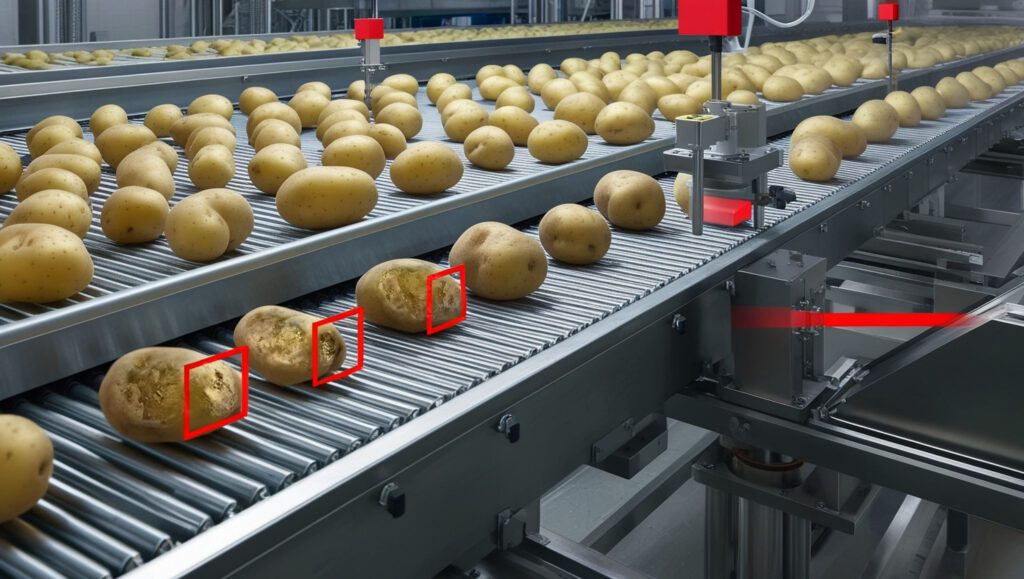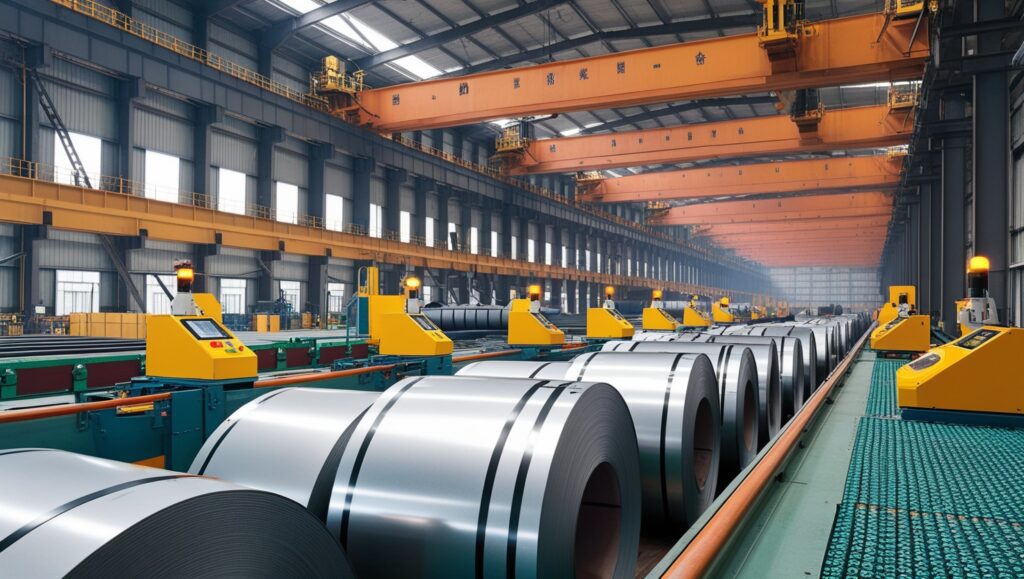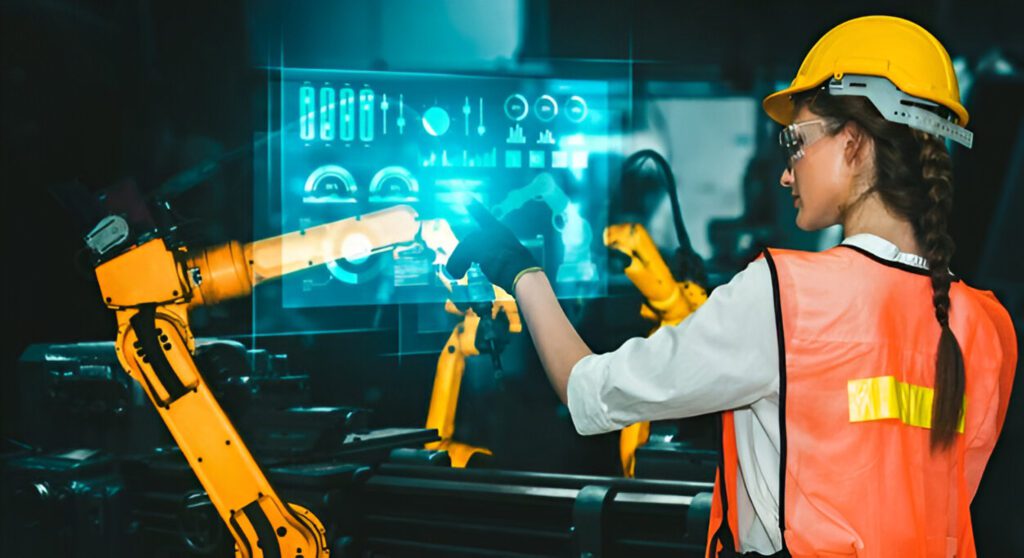Redefining Production Monitoring System with Computer Vision AI
Introduction

In the rapidly evolving landscape of industrial manufacturing, the need for efficient, accurate, and real-time production monitoring has never been more critical. The advent of Industry 5.0 has brought forth a new era where cutting-edge technologies are transforming traditional production monitoring systems. Among these, Computer Vision AI stands out as a game-changer, particularly in production monitoring systems. Computer Vision AI is a transformative technology poised to redefine production monitoring systems, contributing unparalleled accuracy, efficiency, and insight.
Understanding Production Monitoring Systems
Production monitoring systems are critical in manufacturing and industrial settings. They are designed to track, record, and analyze the performance of production processes, as well as identify shortcomings or areas for improvement. Production monitoring systems provide necessary information on equipment efficiency, production rates, downtime, and quality control. Historically, these systems have relied on manual inspections, basic sensors, and human oversight to ensure operation and performance of production lines.
Traditional production monitoring is labor-intensive, relying primarily on human intervention and observation. Apart from being time-consuming, it is also prone to human error, leading to potential inaccuracies in data accumulation and analysis. As industries strive for higher productivity and minimal waste, traditional monitoring systems have certain limitations.
- Manual Errors: Human inspections are prone to errors and inconsistencies.
- Latency: Delays in detecting and addressing issues can lead to significant production downtime.
- Scalability: Traditional systems stumble to scale with increasing production volumes and complexities.
- Data In-accuracy: Disparate systems lead to fragmented data, hindering holistic analysis and decision-making.
The Role of Computer Vision AI in Production Monitoring

Computer Vision AI, a subset of artificial intelligence that enables machines to interpret and understand visual information, has emerged as a powerful tool in production monitoring. By leveraging advanced image processing algorithms, deep learning models, and high-resolution cameras, Computer Vision AI can automate and enhance the monitoring of production processes in unprecedented ways. It mimics human vision by recognizing patterns, identifying objects, and interpreting complex scenes. This technology is placed throughout production facilities, allowing for continuous and automated monitoring of processes.
A Computer Vision AI platform enables real-time inspection of products on the production line, identifying defects and anomalies with high precision. Production Monitoring Systems with computer vision also enable AI for Overall Equipment Effectiveness (OEE) improvement. These systems visualize, analyze, and optimize cycle times for performance, machine availability, and quality metrics to monitor and improve OEE.
Integrating Computer Vision AI technology transforms production monitoring by providing manufacturers with detailed insights into their processes, helping to minimize downtime, reduce waste, and ensure consistent product quality.
Applications of Production Monitoring Systems in Manufacturing Process
Production monitoring systems play a crucial role in modern manufacturing by providing comprehensive oversight and control across various areas of the production process. From raw material inspection to final product quality, production monitoring systems enable manufactures to achieve greater efficiency, improve quality, and optimize resource usage throughout the production cycle.
Here are the various areas of the production process where the application of a production monitoring system can enhance the efficiency of manufacturing processes.
Raw Material Inspection
Production monitoring systems enable raw material inspection, ensuring that incoming materials meet required quality standards. This early-stage real-time monitoring involves verifying the size and specifications of raw materials to ensure they match production requirements. Additionally, these systems detect foreign materials or contaminants that could compromise the quality of the final product. By addressing these issues before production begins, manufacturers can prevent defects from entering the production process, reduce the risk of compromised product quality and address time lag between shifts, ensuring efficient production flow.
Production Line Monitoring
Production line monitoring is a critical application of production monitoring systems, offering real-time insights into the efficiency and performance of the manufacturing process. Computer Vision AI solution enables real-time production line monitoring to analyze visual data to detect potential anomalies such as equipment malfunctions, bottlenecks, or inconsistencies in product quality. By identifying defects, inconsistencies, and deviations from standards in real-time, these systems allow for immediate corrective actions, minimizing disruptions and ensuring smooth production line operation. Production monitoring system provides valuable feedback for process optimization by leveraging advanced analytics and real-time visual data to manufacturers enabling them to adjust workflows, improve throughput, and maintain high-quality standards throughout the production cycle.
Assembly Line Monitoring

Assembly line monitoring enables accuracy, efficiency, and consistency in the assembly process. Production monitoring systems use real-time data collection and advanced analytics to detect incorrect part placements or misalignments, allowing immediate corrective actions. They verify each step of the assembly process to ensure components are correctly positioned and assembled, enhancing overall product quality. Production monitoring systems help optimize workflows and improve throughput by identifying inefficiencies and bottlenecks.
Inventory Management
Computer Vision solutions provide real-time tracking of raw materials, components, and finished goods, ensuring that inventory levels are always right. Production monitoring provides continuous insights into stock levels and usage rates. It also optimizes storage space and minimizes waste by ensuring materials are used efficiently and within their shelf life. Incorporating production monitoring systems into inventory management strategies saves money, streamlines operations, and makes the manufacturing process more efficient and reliable.
Equipment Maintenance
Computer vision AI systems continuously assess the performance and condition of machinery, providing real-time alerts that help prevent unexpected breakdowns. Production monitoring system monitors various parameters such as vibration, temperature, and operating speed to detect signs of wear and tear early. This enables predictive maintenance, allowing for timely interventions before minor issues escalate into major failures. Scheduled maintenance based on actual equipment condition, rather than on fixed intervals, ensures that machinery operates at peak efficiency, reducing downtime and extending the lifespan of the equipment.
Safety and Workforce Monitoring
Incorporating computer vision AI for safety compliance and worker monitoring enhances the safety of the production environment. Production monitoring systems monitor employee actions, ensuring compliance with safety protocols and quickly identifying unsafe practices or conditions. Alerts are generated in real time to prevent accidents and ensure that safety standards are consistently met. The proactive approach of production monitoring systems towards safety protects workers, reduces liability, and enhances the company's reputation as a responsible employer.
Finished Goods Inspection

Production monitoring platform utilizes advanced technologies to perform thorough inspections of finished products, verifying that they meet all specifications and quality standards. Analyzing visual data and conducting automated quality checks identifies defects, inconsistencies, and deviations from the desired standards in real time. This ensures that only products meeting the highest quality criteria are approved for shipment, reducing the risk of customer returns and complaints. Implementing a Production Monitoring Platform for finished goods inspection enhances reliability, maintains product integrity, and supports a high standard of customer satisfaction.
Waste Reduction and Sustainability
Incorporating Computer Vision AI into production monitoring systems enhances efficiency and plays a crucial role in waste reduction and sustainability. Manufacturers can minimize resource wastage by accurately identifying defects and optimizing processes, reducing energy consumption, and contributing to a more sustainable production environment.
Benefits of Production Monitoring System in Manufacturing Sector
Production monitoring systems have become indispensable tools in modern manufacturing, offering a range of benefits that significantly impact operational efficiency and product quality. Integrating Computer Vision AI further amplifies these benefits, bringing advanced capabilities to the forefront of manufacturing processes.
Here’s how they transform the manufacturing sector:
Enhanced Accuracy and Efficiency in Monitoring
Production monitoring systems provide real-time visibility of manufacturing processes, enabling real-time insights and alerts for precise monitoring of production processes to track performance metrics, identify bottlenecks, and optimize workflows. With Computer Vision AI, this efficiency is further enhanced by automating visual inspections and data collection, leading to faster and more accurate process adjustments. This level of accuracy ensures that issues are promptly identified and resolved, maintaining the highest standards of product quality.
Anomaly Detection
Computer Vision AI excels in anomaly Detection in Manufacturing by analyzing visual data for irregular patterns or deviations from normal operations. Production monitoring system capability allows for the early detection of equipment or process deviations, such as equipment malfunctions, product defects, or process inefficiencies, before they escalate into significant problems. Early anomaly detection helps implement timely corrective measures, minimize disruptions, and maintain consistent production quality.
Improved Product Quality
Production monitoring systems equipped with Computer Vision AI can detect deviations from quality standards with high precision. AI-powered image analysis identifies defects and inconsistencies that might be missed by human inspectors, ensuring higher product quality and reducing the likelihood of defective products reaching the market. This enhanced capability of real-time production monitoring systems allows for immediate corrective actions, preventing quality issues from escalating and ensuring consistent product excellence. By integrating Computer Vision AI, manufacturers can achieve unparalleled quality control accuracy, driving better production monitoring outcomes for manufacturers.
Data-Driven Insights

Production monitoring systems with visual AI platforms collect vast amounts of data that are analyzed to uncover trends and patterns. Computer Vision AI adds another layer of analysis by providing insights from visual data, such as detecting subtle quality issues or identifying inefficiencies that might not be apparent through traditional data alone. This enhanced capability allows for more precise quality control and process optimization, significantly improving production performance and product consistency. By integrating these advanced visual analytics with computer vision, manufacturers can achieve a more comprehensive and actionable understanding of their operations and make informed decisions for future improvements based on these insights.
Reduced Downtime
Predictive analytics and real-time production line monitoring enable alerts that help anticipate equipment failures before they occur. Computer Vision AI contributes by monitoring equipment conditions and visualizing wear-and-tear patterns, enabling proactive maintenance and minimizing unplanned downtime. By continuously analyzing visual data, AI can identify emerging issues early, allowing for timely interventions that prevent costly disruptions. This proactive approach ensures smoother operations, extends the lifespan of equipment, and enhances overall production efficiency.
Enhanced Safety
Production monitoring systems ensure a safer workplace by continuously tracking equipment performance and environmental conditions. When integrated with Computer Vision AI, these systems provide advanced safety measures by detecting unsafe conditions and potential hazards through real-time image analysis. This enables quicker responses and corrective actions, significantly reducing the risk of accidents and enhancing overall workplace safety. Additionally, the technology supports ongoing safety improvements by identifying recurring issues and assessing the effectiveness of safety protocols.
Scalability and Flexibility
Production monitoring platform utilizes advanced technologies to perform thorough inspections of finished products, verifying that they meet all specifications and quality standards. Analyzing visual data and conducting automated quality checks identifies defects, inconsistencies, and deviations from the desired standards in real time. This ensures that only products meeting the highest quality criteria are approved for shipment, reducing the risk of customer returns and complaints. Implementing a Production Monitoring Platform for finished goods inspection enhances reliability, maintains product integrity, and supports a high standard of customer satisfaction.
Waste Reduction and Sustainability
Modern production monitoring systems are scalable and adaptable to various manufacturing environments. Computer Vision AI further supports this scalability by allowing systems to be easily adjusted to accommodate different products and production processes, providing flexibility as manufacturing needs evolve.
Conclusion
Computer Vision AI is redefining production monitoring systems, offering manufacturers unprecedented levels of accuracy, efficiency, and insight. By enhancing real-time defect detection, enabling predictive maintenance, optimizing processes, and ensuring safety and compliance, Computer Vision AI addresses many of the limitations of traditional monitoring systems. While challenges exist, a strategic approach to implementing Computer Vision AI can unlock significant benefits, driving operational excellence and competitiveness in the modern manufacturing landscape. Embracing this technology is not just about keeping up with industry trends—it's about positioning your organization for future success in a rapidly evolving market.
Our latest blogs
Insights and perspectives from Ripik.ai's thought leaders
Discover how Vision AI, a cutting-edge technology, surpasses traditional ML models to optimize manufacturing processes, enhance quality control, and boost overall efficiency.
Integrating AI in the cement industry is a much-needed breath of fresh air. We’re on the brink of a new era that’s driven by intelligence and innovation. AI has the potential to solve many persistent problems while simultaneously increasing cement manufacturing efficiency.
Research by Nature claims that artificial intelligence can contribute to fulfilling 79% of the target for sustainable development.
The powerful combination of artificial intelligence and cutting-edge vision AI systems presents a breakthrough way to reach sustainable steel manufacture without compromising output.
Learn how AI-driven preventive maintenance minimizes equipment downtime in heavy manufacturing. Boost efficiency using computer vision and AI technologies.
Computer Vision AI is changing Asset Performance Management (APM) by enabling real-time monitoring and inspection of industrial assets. Vision AI technology can analyze images and video feeds by deploying advanced cameras and algorithms to identify wear and tear, misalignment, and surface defects.
Coal moisture detection ensures that coal is at the right moisture level for optimal burning to enable combustion efficiency.
Enhance Electric Arc Furnace efficiency with real-time monitoring and advanced visual analytics. Track temperature, charge composition, and energy use to boost performance and reduce costs.
The integration of Vision AI into cement kiln operations presents a transformative opportunity for manufacturers to enhance efficiency, reduce costs, and improve product quality.








